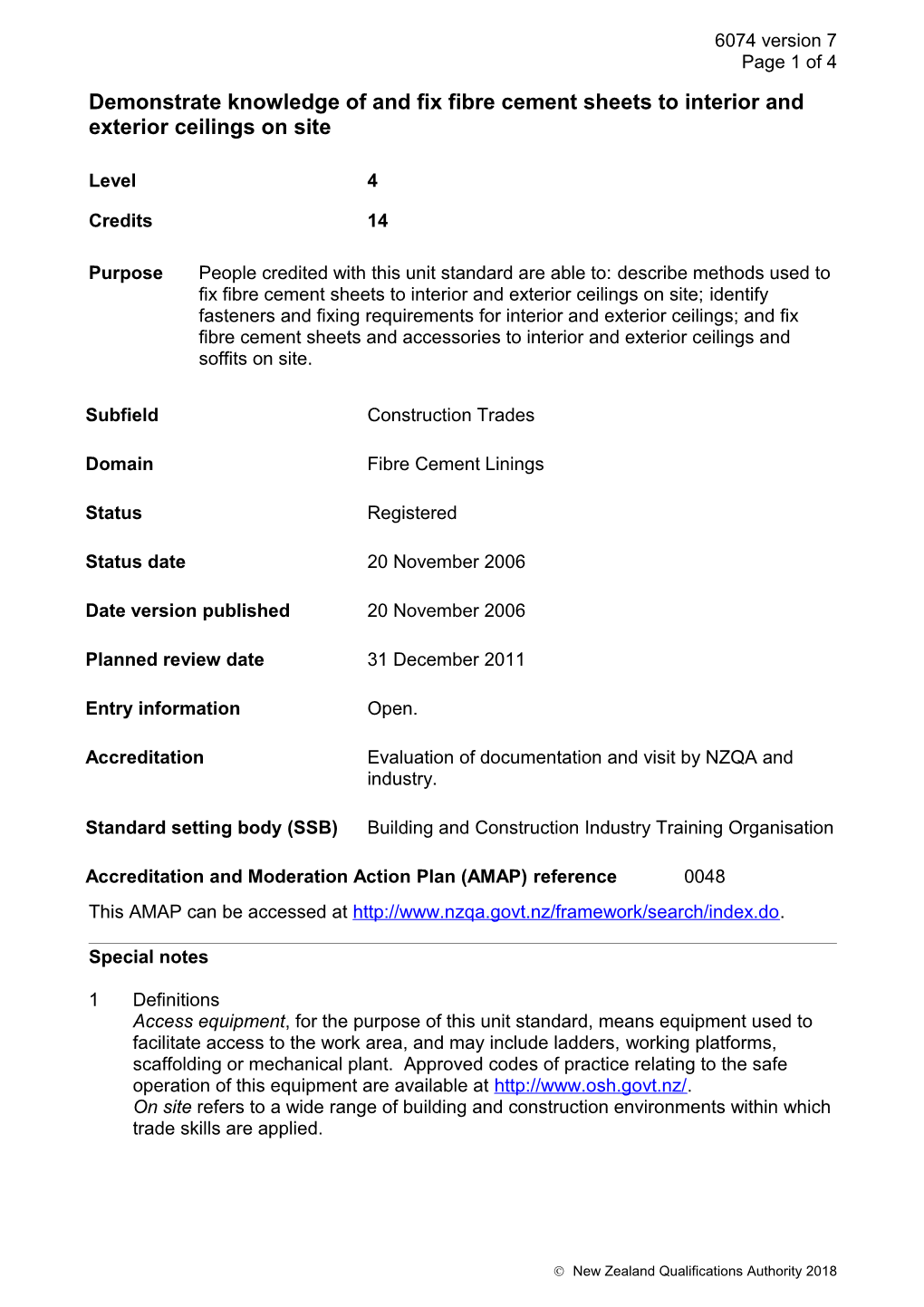6074 version 7
Page 1 of 3
Demonstrate knowledge of and fix fibre cement sheets to interior and exterior ceilings on site
Level / 4Credits / 14
PurposePeople credited with this unit standard are able to: describe methods used to fix fibre cement sheets to interior and exterior ceilings on site; identify fasteners and fixing requirements for interior and exterior ceilings; and fix fibre cement sheets and accessories to interior and exterior ceilings and soffits on site.
Subfield / Construction TradesDomain / Fibre Cement Linings
Status / Registered
Status date / 20 November 2006
Date version published / 20 November 2006
Planned review date / 31 December 2011
Entry information / Open.
Accreditation / Evaluation of documentation and visit by NZQA and industry.
Standard setting body (SSB) / Building and Construction Industry Training Organisation
Accreditation and Moderation Action Plan (AMAP) reference / 0048
This AMAP can be accessed at
Special notes
1Definitions
Access equipment, for the purpose of this unit standard, means equipment used to facilitate access to the work area, and may include ladders, working platforms, scaffolding or mechanical plant. Approved codes of practice relating to the safe operation of this equipment are available at
On site refers to a wide range of building and construction environments within which trade skills are applied.
Specifications refers to documented instructions (oral, written, graphic) and may include any of the following: manufacturer’s specifications, recommendations or technical data sheets; material specifications; specifications from a specialist source such as an architect, designer, engineer or a supervisor; site or work specific requirements.
Work site practice refers to the documented procedures specific to a work site, which set out the standard and required practices of that work site.
2Performance of the elements must meet quality and work requirements of an on-site environment. Work requirements are detailed in the current Industry Productivity Guidelines, which are available from the Building and Construction Industry Training Organisation, PO Box 2615, Wellington.
3All work practices must comply with the following: Health and Safety in Employment Act 1992 and Health and Safety in Employment Regulations 1995; Resource Management Act 1991; Building Act 2004; AS/NZS 2908.2:2000 Cellulose-cement products – Flat sheet, available from Standards NZ (Approved Code of Practice for the Safe Erection and Use of Scaffolding (Wellington: Occupational Safety and Health Service, Department of Labour, 1995) available at
4Credit for this unit standard indicates compliance with industry practice. Industry practice refers to the ability to demonstrate knowledge and skills that reflect the productivity, uniformity, finish quality and material economies currently accepted within industry.
Elements and performance criteria
Element 1
Describe methods used to fix fibre cement sheets to interior and exterior ceilings on site.
Performance criteria
1.1Methods of fixing are described in accordance with manufacturer’s and job specifications.
Rangeinterior ceiling, exterior ceiling.
Element 2
Identify fasteners and fixing requirements for interior and exterior ceilings.
Rangeon site environments include– residential, industrial, commercial, multi-storey;
one environment is required.
Performance criteria
2.1Types of fasteners are identified from working drawings and job specifications.
Rangenails, screws, adhesive; combination.
2.2Installation requirements are identified from the working drawings or job specifications.
Element 3
Fix fibre cement sheets and accessories to interior and exterior ceilings and soffits on site.
Rangetwo of – 4.5mm fibre cement sheet, 6mm fibre cement sheet, 9mm fibre cement sheet;
on site environments include– residential, industrial, commercial, multi-storey;
one environment is required.
Performance criteria
3.1Positions of installed services are confirmed as complying with the working drawings or job specifications.
3.2Work access is arranged in accordance with on-site conditions.
3.3Access equipment is arranged in accordance with the Health and Safety in Employment Regulations.
3.4Sheet layout and jointing are checked and confirmed before fixing.
3.5Sheets are trimmed for the jointing methods specified, projections, and recesses.
3.6Temporary support systems are selected and used as required by the on-site conditions.
3.7Sheets are fixed to the framing or backing as specified to meet manufacturer’s specifications.
3.8Sheet joints are completed in accordance with the job specifications.
RangePVC jointers, mouldings, sealants, tapes.
3.9All operations are completed, workplace and tools cleaned, and tools stored in accordance with work site practice.
Please note
Providers must be accredited by the Qualifications Authority, or an inter-institutional body with delegated authority for quality assurance, before they can report credits from assessment against unit standards or deliver courses of study leading to that assessment.
Industry Training Organisations must be accredited by the Qualifications Authority before they can register credits from assessment against unit standards.
Accredited providers and Industry Training Organisations assessing against unit standards must engage with the moderation system that applies to those standards.
Accreditation requirements and an outline of the moderation system that applies to this standard are outlined in the Accreditation and Moderation Action Plan (AMAP). The AMAP also includes useful information about special requirements for organisations wishing to develop education and training programmes, such as minimum qualifications for tutors and assessors, and special resource requirements.
Comments on this unit standard
Please contact the Building and Construction Industry Training Organisation you wish to suggest changes to the content of this unit standard.
New Zealand Qualifications Authority 2018
